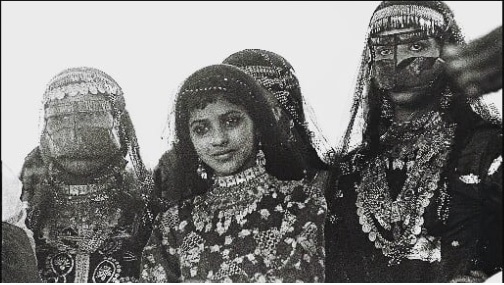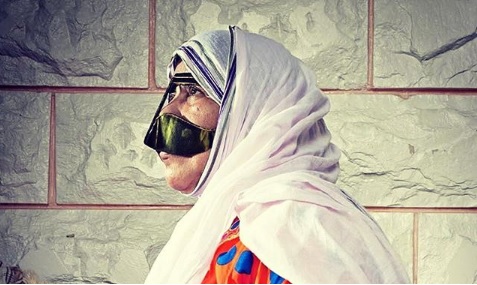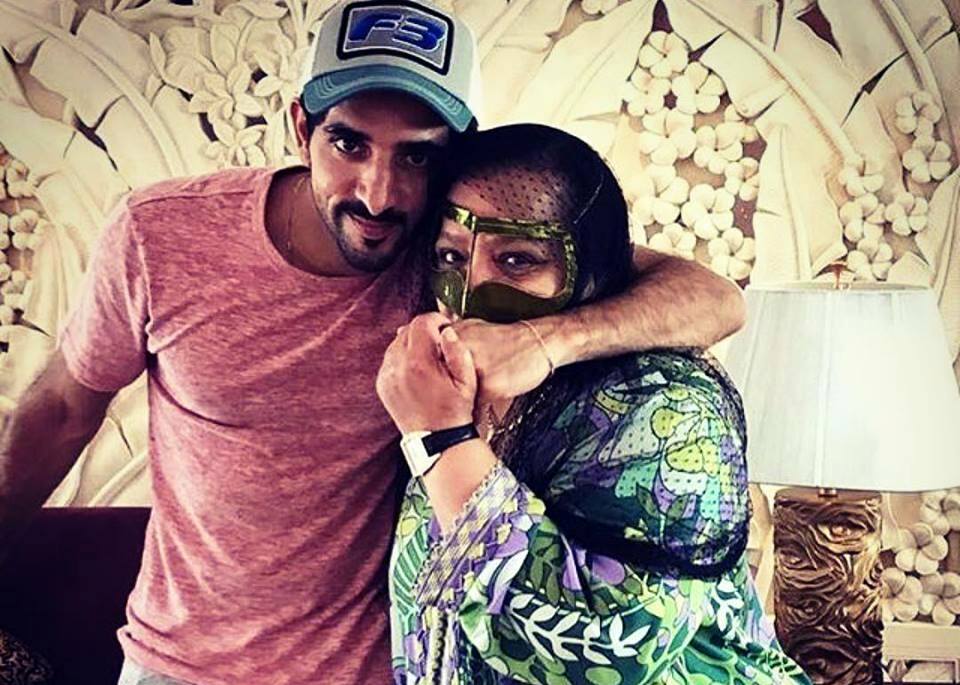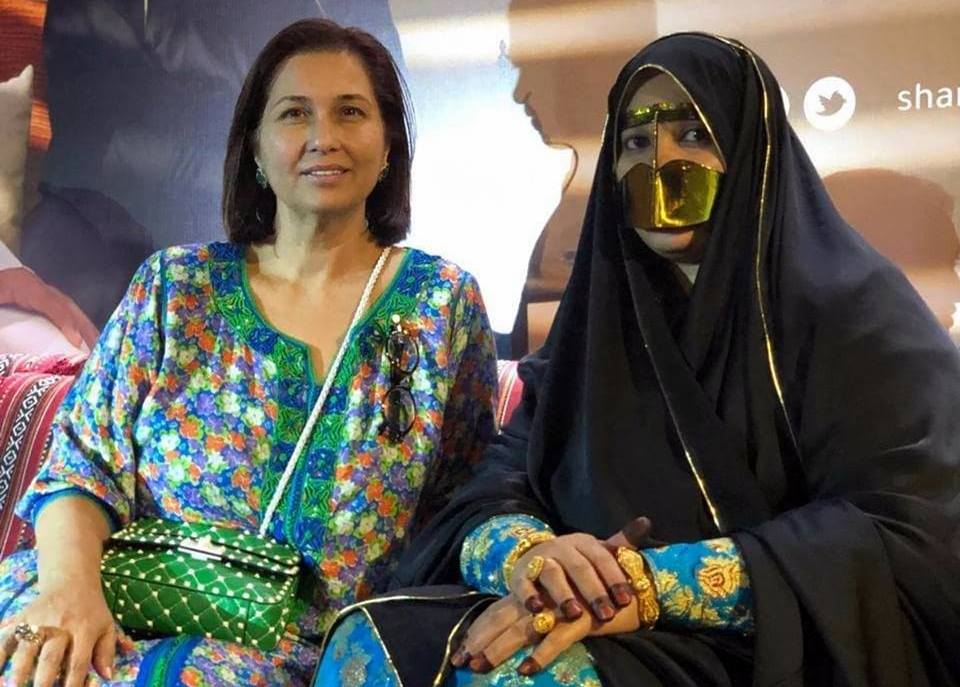




Veiling or concealing the body and face has been a general practice in the Gulf region for ages. As the natives of this region are all followers of Islam, the act of concealing has generally been associated with religion. In this post, we will look at whether and how religion affected women’s dress in the region. This is not a discussion on the doctrines of Islam, but rather a brief look at the sources within Islam that encouraged veiling practices and how it has developed over time. We will then look at the different styles of face covering practised in the UAE and how it has changed.

The general term ‘veil’ has different meanings in various parts of the region and are used to refer to different types of garments. Local Arab and Muslim cultures have a different understanding of the practice of veiling than those in other cultures. We will look at three basic styles of covering or veils worn within the UAE culture over the next few posts: facemask, head cover, and full body cover.
Although veiling is a custom that is generally associated with Islam, it has pre-Islamic roots and can be traced back to Assyrian times when it was used as a means to distinguish between the social classes. In 1500 BC Assyrian women were prohibited to appear in public unveiled while slave women were prohibited to cover their faces. The custom of veiling for status and honour spread throughout the Arabian Peninsula via trading and interaction with Persia and Byzantium during pre-Islamic times.
In her Sultani
Sulṭānī: (Arabic: sultān: king). In the UAE the term denotes to silk satin fabric in multiple vertical striped colours, commonly used for tunics (kanadir) and underpants (sarāwīl). Also refers to book: Sultani, Traditions Renewed, Changes in women’s traditional dress In the United Arab Emirates during the reign of the late Shaykh Zāyid Bin Sultan āl Nahyān, 1966-2004, By Dr. Reem Tariq
Ṭariq: (Arabic; Synonym: tulle_bi_talli
Tūlle_bi_tallī: (French: Tulle – a city in France where fine material for veil was first made; Turkish: tel – wire; Synonym: tariq; talli; badla; khus_dozi ), series of small metal knots made on a woven net ground as embellishment. The term is commonly used in the North African Arab region specifically in Egypt. Ṭariq: (Arabic; Synonym: tulle_bi_talli
Tūlle_bi_tallī: (French: Tulle – a city in France where fine material for veil was first made; Turkish: tel – wire; Synonym: tariq; talli; badla; khus_dozi ), series of small metal knots made on a woven net ground as embellishment. The term is commonly used in the North African Arab region specifically in Egypt.

Islamic thought regarding dress is founded on the legislation in the holy Qur’an, the hadith, which are traditions of the Prophet (S.) and their authorised scholarly interpretations, and ijma, which is the consensus of eminent scholars at various periods. A study of the Qur’an reveals eight ayat (verses) that mention particular articles of dress (e.g. al-sarabil and al-qamis
Qamīṣ: (Possibly late Latin: Camisia – Linen Undergarment; Synonym: Kamiz), a traditional loose fitting long tunic or shirt worn by both men and women in South and Central Asia and the Arab world. Typically extending below the waist it is usually paired with a pair of trousers.
), but not in the context of a specific doctrine. Some verses address these items as part of dress in general, while a number of other verses address women’s dress in particular and form the basis of the Qur’anic influence on the issue. A single verse dictates the ordinance of dress concerning elderly women; two verses lay down the basic regulations of dress concerning women in general; four verses instruct the Prophet (S.) regarding his own wives; and four verses emphasise that both men and women should lower their gaze and guard their modesty.
In the Qur’an there is no specific injunction indicating that women should be veiled or secluded from participation in public life. Although in the hadith a stricter measure of veiling is suggested. The impact of hadith is more ambiguous because it depends on views and diverse interpretations derived from many religious scholars of Islam. It is argued that this ambiguity may be one of the blessings bestowed upon the people of Islam. Through it, Muslims gain a certain elasticity of application, which keeps the path open for further deliberation and new thought.
To give the topic the study it warrants one must compare and consult the collection of traditions by Anas ibn Malik and the interpretations of the collections of traditions by the six most prominent scholars in this field: Muhammad ibn Isma’il al-Bukhari, Muslim ibn al-Hajjaj al-Qushayri, Muhammad Isa Al-Tirmidhi, Abu-Da’ud, Ahmed ibn Shu’ayib Al-Nasa’i, and Muhammad ibn-Yazid Ibn-Majah.
Most of them agree that Islam allows a woman to have her face, palms of her hands, and her feet visible cautioning that both her appearance and behaviour must stay demure and respectable. This point is further emphasised as women continue to be instructed to refrain from wearing the veil that covers their faces when performing the five daily prayers and as they worship during Hajj.

The coastal societies of the Arabian Peninsula were exposed to influences from the Persian side of the Gulf as well as the countries further East, like Pakistan, Baluchistan and India. Veiling in various forms were part of these cultures and had an influence on local society. The Gulf region remained almost untouched by external influences until the twentieth century, creating isolated tribal communities where the way of life was shaped by tribal customs and traditions. Honour played an important role in the status of the tribes with the chastity of their women as the embodiment of this honour.
In contrast, the severe climate conditions and scarcity of resources lead to women dressing in lightweight clothing during daily activities within these isolated communities. Photos from the 1950s depict women with dresses so transparent that their silhouettes are clearly visible through the sheer fabric even though their faces and heads are covered. Some garments had extended side slits or loose-fitting sleeves, exposing the woman’s skin and revealing the upper body. This is in contradiction to the current practice of complete concealment followed by most UAE women.
Read more about the style and history of UAE thawb
Thawb: (Arabic: thawb, Pl. Athwāb/thībān), can be pronounced thobe
Thobe: (Arabic: thawb, Pl. Athwāb/thībān), can be pronounced thawb or tobe
Tobe: (Arabic: thawb, Pl. Athwāb/thībān), can be pronounced thawb or thobe based on locale. The standard Arabic word for ‘fabric’ or ‘garment’. It can refer to a qamīs-like tunic worn by men and women in the Arabian Peninsula, Iraq, the southern and south-western ports and islands of Iran, and some countries in East and West Africa. More specifically, it can refer to the square-shaped Bedouin overgarment worn by women. based on locale. The standard Arabic word for ‘fabric’ or ‘garment’. It can also refer to a qamīs-like tunic worn by men and women in the Arabian Peninsula, Iraq, the southern and south-western ports and islands of Iran, and some countries in East and West Africa. More specifically, it can refer to the square-shaped Bedouin overgarment worn by women. or tobe
Tobe: (Arabic: thawb, Pl. Athwāb/thībān), can be pronounced thawb or thobe based on locale. The standard Arabic word for ‘fabric’ or ‘garment’. It can refer to a qamīs-like tunic worn by men and women in the Arabian Peninsula, Iraq, the southern and south-western ports and islands of Iran, and some countries in East and West Africa. More specifically, it can refer to the square-shaped Bedouin overgarment worn by women. based on locale. The standard Arabic word for ‘fabric’ or ‘garment’. It can also refer to a qamīs-like tunic worn by men and women in the Arabian Peninsula, Iraq, the southern and south-western ports and islands of Iran, and some countries in East and West Africa. More specifically, it can refer to the square-shaped Bedouin overgarment worn by women in the Arabian Gulf region.
(opens in a new tab)" href="https://thezay.org//the-story-of-the-uae-thawb/" target="_blank">thawb
Thawb: (Arabic: thawb, Pl. Athwāb/thībān), can be pronounced thobe
Thobe: (Arabic: thawb, Pl. Athwāb/thībān), can be pronounced thawb or tobe
Tobe: (Arabic: thawb, Pl. Athwāb/thībān), can be pronounced thawb or thobe based on locale. The standard Arabic word for ‘fabric’ or ‘garment’. It can refer to a qamīs-like tunic worn by men and women in the Arabian Peninsula, Iraq, the southern and south-western ports and islands of Iran, and some countries in East and West Africa. More specifically, it can refer to the square-shaped Bedouin overgarment worn by women. based on locale. The standard Arabic word for ‘fabric’ or ‘garment’. It can also refer to a qamīs-like tunic worn by men and women in the Arabian Peninsula, Iraq, the southern and south-western ports and islands of Iran, and some countries in East and West Africa. More specifically, it can refer to the square-shaped Bedouin overgarment worn by women. or tobe
Tobe: (Arabic: thawb, Pl. Athwāb/thībān), can be pronounced thawb or thobe based on locale. The standard Arabic word for ‘fabric’ or ‘garment’. It can refer to a qamīs-like tunic worn by men and women in the Arabian Peninsula, Iraq, the southern and south-western ports and islands of Iran, and some countries in East and West Africa. More specifically, it can refer to the square-shaped Bedouin overgarment worn by women. based on locale. The standard Arabic word for ‘fabric’ or ‘garment’. It can also refer to a qamīs-like tunic worn by men and women in the Arabian Peninsula, Iraq, the southern and south-western ports and islands of Iran, and some countries in East and West Africa. More specifically, it can refer to the square-shaped Bedouin overgarment worn by women in the Arabian Gulf region. and kandurah
Kandūrah: (Arabic: qandūrah, pl. kanādīr, synonyms: ghandurah, qandurah
Qandūrah: (Arabic, pl. qanādīr, synonyms: ghandurah, darā’ah, dishdāshah, jalābah, jallābīyah, qaftan, mqta’, thawb
Thawb: (Arabic: thawb, Pl. Athwāb/thībān), can be pronounced thobe
Thobe: (Arabic: thawb, Pl. Athwāb/thībān), can be pronounced thawb or tobe
Tobe: (Arabic: thawb, Pl. Athwāb/thībān), can be pronounced thawb or thobe based on locale. The standard Arabic word for ‘fabric’ or ‘garment’. It can refer to a qamīs-like tunic worn by men and women in the Arabian Peninsula, Iraq, the southern and south-western ports and islands of Iran, and some countries in East and West Africa. More specifically, it can refer to the square-shaped Bedouin overgarment worn by women. based on locale. The standard Arabic word for ‘fabric’ or ‘garment’. It can also refer to a qamīs-like tunic worn by men and women in the Arabian Peninsula, Iraq, the southern and south-western ports and islands of Iran, and some countries in East and West Africa. More specifically, it can refer to the square-shaped Bedouin overgarment worn by women. or tobe
Tobe: (Arabic: thawb, Pl. Athwāb/thībān), can be pronounced thawb or thobe based on locale. The standard Arabic word for ‘fabric’ or ‘garment’. It can refer to a qamīs-like tunic worn by men and women in the Arabian Peninsula, Iraq, the southern and south-western ports and islands of Iran, and some countries in East and West Africa. More specifically, it can refer to the square-shaped Bedouin overgarment worn by women. based on locale. The standard Arabic word for ‘fabric’ or ‘garment’. It can also refer to a qamīs-like tunic worn by men and women in the Arabian Peninsula, Iraq, the southern and south-western ports and islands of Iran, and some countries in East and West Africa. More specifically, it can refer to the square-shaped Bedouin overgarment worn by women in the Arabian Gulf region. or tobe
Tobe: (Arabic: thawb, Pl. Athwāb/thībān), can be pronounced thawb or thobe based on locale. The standard Arabic word for ‘fabric’ or ‘garment’. It can refer to a qamīs-like tunic worn by men and women in the Arabian Peninsula, Iraq, the southern and south-western ports and islands of Iran, and some countries in East and West Africa. More specifically, it can refer to the square-shaped Bedouin overgarment worn by women. ), a loose, short or long-sleeved, shirt like (qamis) tunic with frontal neckline opening, worn by both sexes. Each Arab region has a different term for what is essentially a similar garment with various small differences. , dra’ah, dishdāshah, jallābīyah, jalābah, jillābīyah, qaftan
Qafṭān: (Persian: khaftān, Pl. qafāṭin, synonyms: ghandurah, qandurah
Qandūrah: (Arabic, pl. qanādīr, synonyms: ghandurah, darā’ah, dishdāshah, jalābah, jallābīyah, qaftan, mqta’, thawb
Thawb: (Arabic: thawb, Pl. Athwāb/thībān), can be pronounced thobe
Thobe: (Arabic: thawb, Pl. Athwāb/thībān), can be pronounced thawb or tobe
Tobe: (Arabic: thawb, Pl. Athwāb/thībān), can be pronounced thawb or thobe based on locale. The standard Arabic word for ‘fabric’ or ‘garment’. It can refer to a qamīs-like tunic worn by men and women in the Arabian Peninsula, Iraq, the southern and south-western ports and islands of Iran, and some countries in East and West Africa. More specifically, it can refer to the square-shaped Bedouin overgarment worn by women. based on locale. The standard Arabic word for ‘fabric’ or ‘garment’. It can also refer to a qamīs-like tunic worn by men and women in the Arabian Peninsula, Iraq, the southern and south-western ports and islands of Iran, and some countries in East and West Africa. More specifically, it can refer to the square-shaped Bedouin overgarment worn by women. or tobe
Tobe: (Arabic: thawb, Pl. Athwāb/thībān), can be pronounced thawb or thobe based on locale. The standard Arabic word for ‘fabric’ or ‘garment’. It can refer to a qamīs-like tunic worn by men and women in the Arabian Peninsula, Iraq, the southern and south-western ports and islands of Iran, and some countries in East and West Africa. More specifically, it can refer to the square-shaped Bedouin overgarment worn by women. based on locale. The standard Arabic word for ‘fabric’ or ‘garment’. It can also refer to a qamīs-like tunic worn by men and women in the Arabian Peninsula, Iraq, the southern and south-western ports and islands of Iran, and some countries in East and West Africa. More specifically, it can refer to the square-shaped Bedouin overgarment worn by women in the Arabian Gulf region. or tobe
Tobe: (Arabic: thawb, Pl. Athwāb/thībān), can be pronounced thawb or thobe based on locale. The standard Arabic word for ‘fabric’ or ‘garment’. It can refer to a qamīs-like tunic worn by men and women in the Arabian Peninsula, Iraq, the southern and south-western ports and islands of Iran, and some countries in East and West Africa. More specifically, it can refer to the square-shaped Bedouin overgarment worn by women. ), a loose, short or long-sleeved, shirt like (qamis) tunic with frontal neckline opening, worn by both sexes. Each Arab region has a different term for what is essentially a similar garment with various small differences. , drā’ah, dishdāshah, jalābah, jallābīyah, kandurah, mqta’, thawb
Thawb: (Arabic: thawb, Pl. Athwāb/thībān), can be pronounced thobe
Thobe: (Arabic: thawb, Pl. Athwāb/thībān), can be pronounced thawb or tobe
Tobe: (Arabic: thawb, Pl. Athwāb/thībān), can be pronounced thawb or thobe based on locale. The standard Arabic word for ‘fabric’ or ‘garment’. It can refer to a qamīs-like tunic worn by men and women in the Arabian Peninsula, Iraq, the southern and south-western ports and islands of Iran, and some countries in East and West Africa. More specifically, it can refer to the square-shaped Bedouin overgarment worn by women. based on locale. The standard Arabic word for ‘fabric’ or ‘garment’. It can also refer to a qamīs-like tunic worn by men and women in the Arabian Peninsula, Iraq, the southern and south-western ports and islands of Iran, and some countries in East and West Africa. More specifically, it can refer to the square-shaped Bedouin overgarment worn by women. or tobe
Tobe: (Arabic: thawb, Pl. Athwāb/thībān), can be pronounced thawb or thobe based on locale. The standard Arabic word for ‘fabric’ or ‘garment’. It can refer to a qamīs-like tunic worn by men and women in the Arabian Peninsula, Iraq, the southern and south-western ports and islands of Iran, and some countries in East and West Africa. More specifically, it can refer to the square-shaped Bedouin overgarment worn by women. based on locale. The standard Arabic word for ‘fabric’ or ‘garment’. It can also refer to a qamīs-like tunic worn by men and women in the Arabian Peninsula, Iraq, the southern and south-western ports and islands of Iran, and some countries in East and West Africa. More specifically, it can refer to the square-shaped Bedouin overgarment worn by women in the Arabian Gulf region. or tobe
Tobe: (Arabic: thawb, Pl. Athwāb/thībān), can be pronounced thawb or thobe based on locale. The standard Arabic word for ‘fabric’ or ‘garment’. It can refer to a qamīs-like tunic worn by men and women in the Arabian Peninsula, Iraq, the southern and south-western ports and islands of Iran, and some countries in East and West Africa. More specifically, it can refer to the square-shaped Bedouin overgarment worn by women. ) loose, short or long-sleeved, shirt like (qamis
Qamīṣ: (Possibly late Latin: Camisia – Linen Undergarment; Synonym: Kamiz), a traditional loose fitting long tunic or shirt worn by both men and women in South and Central Asia and the Arab world. Typically extending below the waist it is usually paired with a pair of trousers. Qamīṣ: (Possibly late Latin: Camisia – Linen Undergarment; Synonym: Kamiz), a traditional loose fitting long tunic or shirt worn by both men and women in South and Central Asia and the Arab world. Typically extending below the waist it is usually paired with a pair of trousers. Qamīṣ: (Possibly late Latin: Camisia – Linen Undergarment; Synonym: Kamiz), a traditional loose fitting long tunic or shirt worn by both men and women in South and Central Asia and the Arab world. Typically extending below the waist it is usually paired with a pair of trousers. Qamīṣ: (Possibly late Latin: Camisia – Linen Undergarment; Synonym: Kamiz), a traditional loose fitting long tunic or shirt worn by both men and women in South and Central Asia and the Arab world. Typically extending below the waist it is usually paired with a pair of trousers.

The development of the oil industry brought rapid changes to the cultural and social dynamics in the UAE. Ironically, the influx of foreign workers and their families into the region encouraged the continued use of the veil. First, to protect the women from the eyes of foreigners and later as a symbol of their national identity. International media and an awareness of international styles and fashion did influence the appearance of face covers - some styles became less popular while others became more fashionable.
The rapid increase in wealth created a privileged and wealthy society with the upper class, especially the ruling family, adhering to the veil to distinguish themselves from the lower social levels. The rest of society caught on, adopting the veil as a status symbol, wearing it over their newly acquired western outfits.
There is no written law in the UAE regarding the wearing of a veil, be it a face mask or a full body cover, in public – it is a personal choice and a strong social statement by the UAE upper classes. But as more women became involved in the workforce and started interacting with the general public, the found the veil to be restricting and a hindrance in their everyday duties. Increased exposure to neighbouring Islamic Arab and other Muslim societies also introduced different religious traditions and new interpretations of Islamic thought and doctrine. This sparked a conflict between the traditional social acceptance of veiled women and the veiling requirements derived from the Qur’an and the hadith. This confluence of religious requirements and social behaviour meant that women viewed as chaste and modest had become a symbol of status and high class.
It was and still is pertinent that women appear modest and not draw male attention to themselves, leading to concealment and segregation of the sexes. Religious guidelines ordained that both men and women share this responsibility in chaste and moral behaviour, but various political and religious interpretations resulted in women bearing the greater responsibility, and culpability, for improper behaviour.
Although the covering of women might seem restrictive and prohibitive, with the face cover, the niqab Niqāb: (Arabic: face cover), cloth face veil or mask with two cutouts, holes or openings for the eyes., demonstrating extreme religious fundamentalism in the eyes of the West, it has ironically enabled women to move free and anonymous in public. The niqab Niqāb: (Arabic: face cover), cloth face veil or mask with two cutouts, holes or openings for the eyes. was revived in Cairo in the early 1970s as a symbol of Islamic fundamentalism but in the UAE, it has recently become popular for more practical reasons such as moving around incognito in public.

Ṭariq: (Arabic; Synonym: tulle_bi_talli
Tūlle_bi_tallī: (French: Tulle – a city in France where fine material for veil was first made; Turkish: tel – wire; Synonym: tariq; talli; badla; khus_dozi ), series of small metal knots made on a woven net ground as embellishment. The term is commonly used in the North African Arab region specifically in Egypt.
Today, fashion and dress are still an integral part of society – as a symbol of status and as a growing business and commercial sector. Institutions like the Islamic Fashion & Design Council under leadership and vision of Alia Khan, with movements like the Modest Fashion Revolution, managed to elevate traditional styles of clothes into the 21st century. Although few modern women still cover their faces, head and body covers have become part of the modern woman’s wardrobe in the UAE and the wider Arab community.
The Zay Zay: (Arabic: costume, Pl. azyaā’), a set of clothes in a style typical of a particular country or historical period. Initiative is honoured to have Alia Khan as a member of our Circle of Advisors.

Ṭariq: (Arabic; Synonym: tulle_bi_talli
Tūlle_bi_tallī: (French: Tulle – a city in France where fine material for veil was first made; Turkish: tel – wire; Synonym: tariq; talli; badla; khus_dozi ), series of small metal knots made on a woven net ground as embellishment. The term is commonly used in the North African Arab region specifically in Egypt.
In the next posts, we will look at the different styles of face covers in more detail.
We would love to hear from you if you have a story about growing up in the UAE, wearing head or face covers, or if you have photos of your family wearing traditional attire that you would like to share with us.